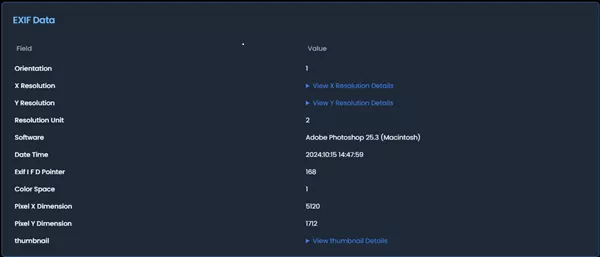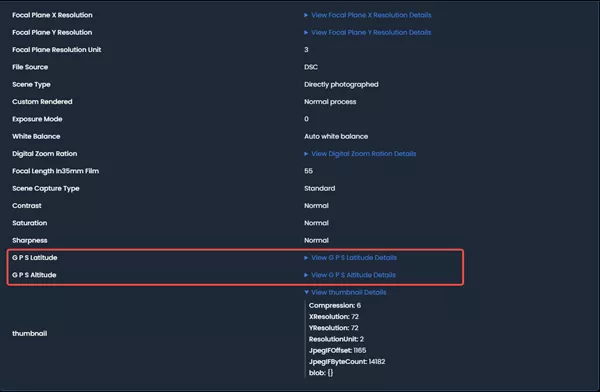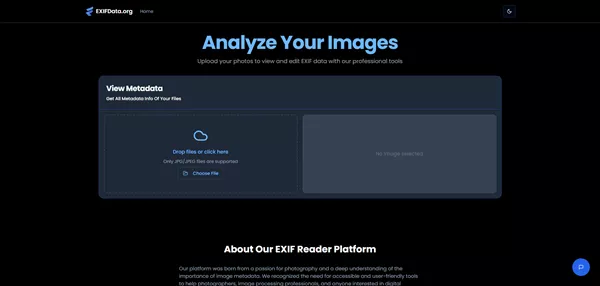What is EXIF Data and Why Should You Care?
Are you a photography enthusiast or simply someone who loves capturing moments with your smartphone? You might be surprised to learn that every digital photo you take contains a wealth of hidden information known as EXIF data. But what is EXIF data, and why should you even care about it? Let's dive in and unlock the secrets hidden within your images. Click here to understand more about image information.

Unveiling the Mystery: What Exactly is EXIF Data?
EXIF (Exchangeable Image File Format) data is essentially metadata that's automatically embedded in your digital photos. Think of it as a digital fingerprint for your images, providing a detailed record of how, when, and where they were captured. This information can be incredibly valuable, offering insights into your photography techniques and helping you manage your photo collection more effectively.
Common Types of EXIF Data
The specific image metadata included in an EXIF file can vary depending on your camera or smartphone, but some of the most common types include:

- Camera Model: Identifies the camera or smartphone used to take the photo.
- Date and Time: Records the exact date and time the photo was captured.
- Aperture: Indicates the lens aperture setting used for the shot.
- Shutter Speed: Shows the shutter speed setting.
- ISO: Reflects the ISO sensitivity setting.
- GPS Location: If enabled, records the precise GPS coordinates where the photo was taken.
- Copyright Information: May include the photographer's name or copyright notice.
Why is Understanding Image Metadata Important?
The Benefits of EXIF Data for Photographers and Casual Users
For Photographers:
Understanding exif data can be a game-changer for photographers looking to improve their skills. By analyzing the metadata of their best shots, they can identify the camera settings that work best in different situations. For instance, knowing the photo information about the aperture, shutter speed, and ISO can help them recreate similar results in the future. Additionally, exif data can be used to protect their work by embedding copyright information directly into the image files.
For Casual Users:
Even if you're not a professional photographer, exif data can still be incredibly useful. It can help you organize your photo library, making it easier to find specific images based on the date, location, or camera used. The GPS data can also be fun, allowing you to see exactly where you took that memorable vacation photo.

The Hidden Danger: EXIF Data and Your Privacy
While exif data can be incredibly useful, it's important to be aware of the potential privacy risks. The GPS location data embedded in your photos can reveal exactly where you were when you took the picture. This information could potentially be used by criminals or stalkers to track your movements or even identify your home address.
What kind of privacy do you need?
For example, if you upload photos to social media or share them online, that location data could be exposed to a wider audience than you intended. Therefore, knowing how to check exif data is essential.
How to View and Manage EXIF Data
Fortunately, it's easy to view and manage the exif data embedded in your photos. There are a variety of tools available, ranging from online viewers to desktop software and mobile apps.
Online EXIF Viewers: A Quick and Easy Solution
Our website, offers a free and easy-to-use exif data viewer. Simply upload your image, and our tool will instantly display all the embedded metadata. This is a great option if you need to quickly check the exif data of a photo without installing any software.

Desktop Software and Mobile Apps: More Powerful Options
For more advanced metadata viewer features, you can also use desktop software like Adobe Bridge or mobile apps like Photo Investigator. These tools allow you to not only view image metadata but also edit or remove it entirely.
Taking Control: Editing and Removing EXIF Data for Enhanced Privacy
Why Remove EXIF Data?
Removing exif data is a simple yet effective way to protect your privacy. By stripping away the location data and other sensitive information, you can share your photos online without revealing your whereabouts or other personal details. Also, it can help you remove metadata from your image.
How to Remove EXIF Data Easily
Our website, also provides a convenient metadata remover. You can remove exif data with just a few clicks. Simply upload your photo, and our tool will remove all the embedded metadata, ensuring your privacy is protected. Click here and start securing your photos.
FAQ: Addressing Your EXIF Data Questions
What is the purpose of EXIF data?
EXIF data provides valuable information about your photos, including camera settings, date and time, and GPS location. This information can be used to improve your photography skills, manage your photo collection, and protect your copyright.
Does all photos contain EXIF data?
Most digital photos contain EXIF data, but it's possible to remove it using specialized tools. Screenshots and some image editing programs may strip away EXIF data as well.
Is EXIF data safe?
EXIF data itself is not inherently unsafe, but the information it contains (especially GPS location) can pose a privacy risk if shared publicly.
Take Control of Your Image Information
EXIF data is a powerful tool that can provide valuable insights into your photos and help you manage your collection more effectively. However, it's also important to be aware of the potential privacy risks and take steps to protect your personal information. By using our website exifdata.org, you can easily view, edit, and remove exif data to ensure your photos are both informative and secure. Start exploring the world of exif data today!